The History of Home, Part 1
Many things in life make us feel comfortable and safe, but often nothing does so quite like home. Whether it is visiting your family or seeing your favorite sports team, home just means more than other places. It’s a place you feel alive, a place to which you feel connected.
For Trojans, no place has earned as much love and support as The Vet. However, this hasn’t been the only location the Trojans have called home.
Watkins Park (1909) – 1-0-1 record
Troy played its first season of competitive football 100 seasons ago exactly in 1909. Though there have been bumps in the road, it has been a pretty steady pace upwards. There had to be a foundation to the Walls of Troy and that foundation was Watkins Park.
While I am not totally sure where Watkins Park was, it served as the home field for the Normalites during the first three-game season of play. I found a reference to Watkins Park as being the location for the second Union Springs game on Nov. 25, 1909, and Troy’s second home game after Edgar School 5 days earlier. I have yet to find a detailed write-up of the Edgar School game to confirm it was played at Watkins Park, however.
This park, wherever it was, would only serve the Trojans for this first season before first coach and Athletics Director, Vergil P. McKinley found a spot on Orion Street for building the new College Athletic Park.
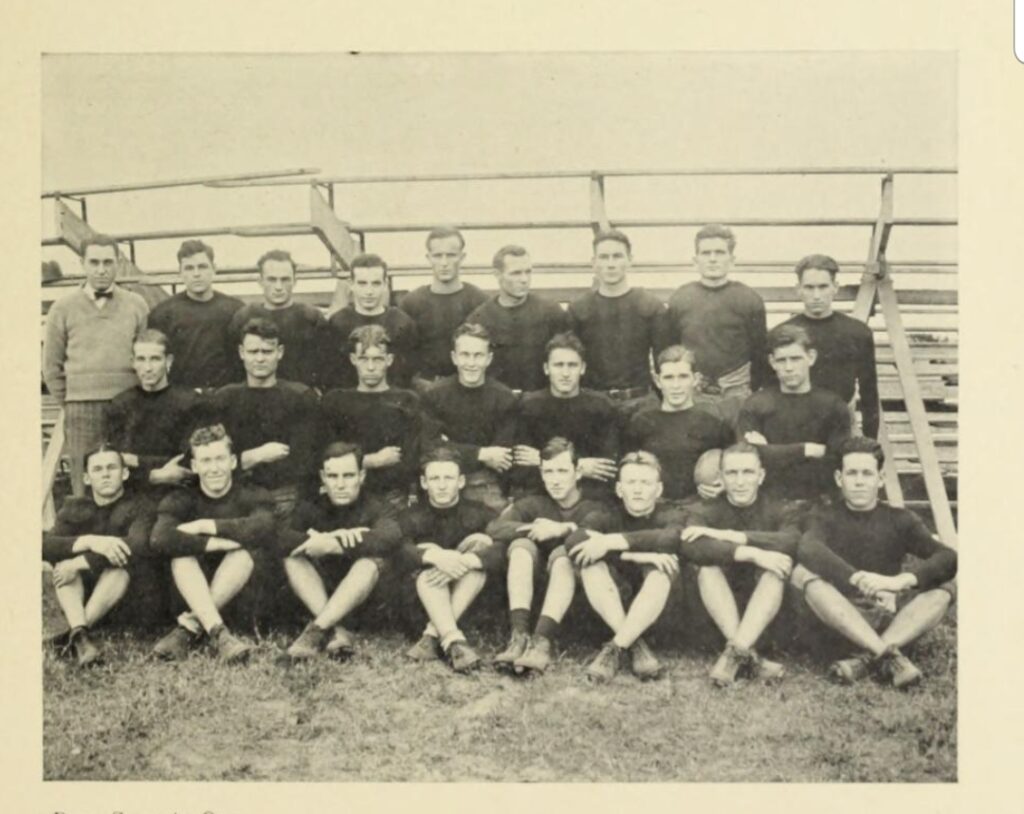
College Athletic Park (1910-1931)
McKinley knew early on that, for Troy to succeed, they needed a place to call their own. That led to the creation of the College Athletic Park on Orion Street. This was the first time Troy had a home field. Ironically, they wouldn’t be the only Trojans calling the CAP home— the college baseball team and the Troy Trojans baseball club of the Alabama-Florida League would play a few seasons there as well.
I couldn’t find much about this stadium other than a few small details. As mentioned, it was a multi-sport stadium and, upon opening, it could seat 400 spectators. The opening game was a baseball game on April 8, 1910, a 12-4 win over the Troy town team. Not much is known about this park, short of its grandstand, bleachers and impressive 6-foot high fence. While playing in the College Athletic Park, the Trojans/Teachers/Normalites had a record of 29-13-4.
The Troy media guides, since at least 2006, have stated that this park was constructed on the north end of the old downtown campus, but contemporary reports in fact place it on Orion Street, “on several acres of the Gellerstedt estate on Orion Street, and just beyond the Walter Wilkerson residence.” If anyone can help me pinpoint where this was located exactly, it would be much appreciated.
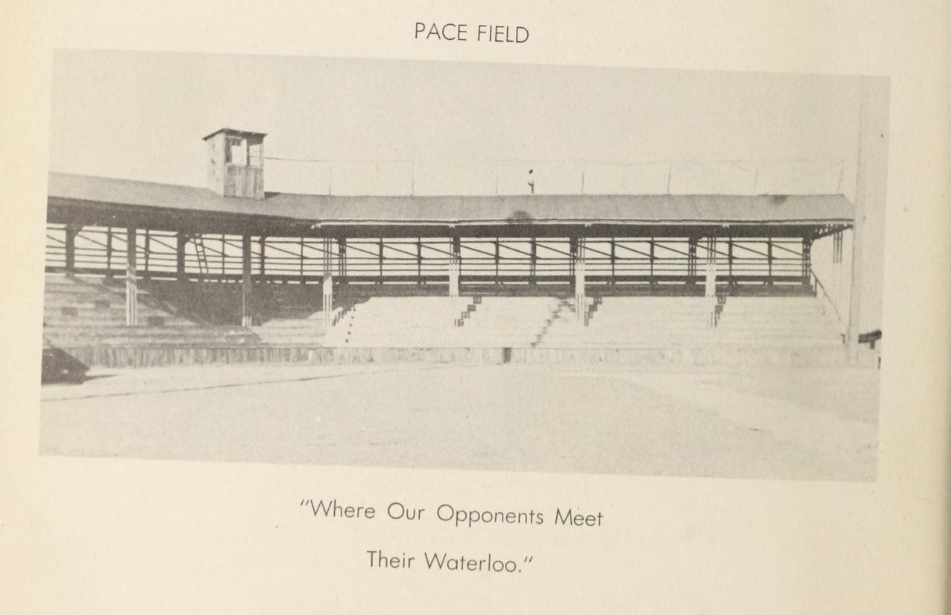
Pace Field (1931-1950)
If there is one place in Troy Athletics lore with more history than The Vet, it’s Pace Field; it’s fitting the football team played here as well. The now Riddle-Pace Field is riddled with baseball history, but Troy was able to come into its own as a football team just off University Ave.
The switch from College Athletic Park to Pace Field was necessitated in 1930 by the College moving from its downtown Troy location to its much more familiar confines just southeast. With the change came the need to build an on-campus facility, something other in-state universities have only just figured out how to do.
The first reference I found to the new Pace Athletic Park was a newspaper clipping from a baseball game played on the field in June of 1931. The first football game played on Pace Field was most likely a Sept. 25, 1931 game with the mysterious Norman. However, the only documented source I can find that puts a game in Pace Field is an Oct. 24, 1931 showdown with Fort Benning.
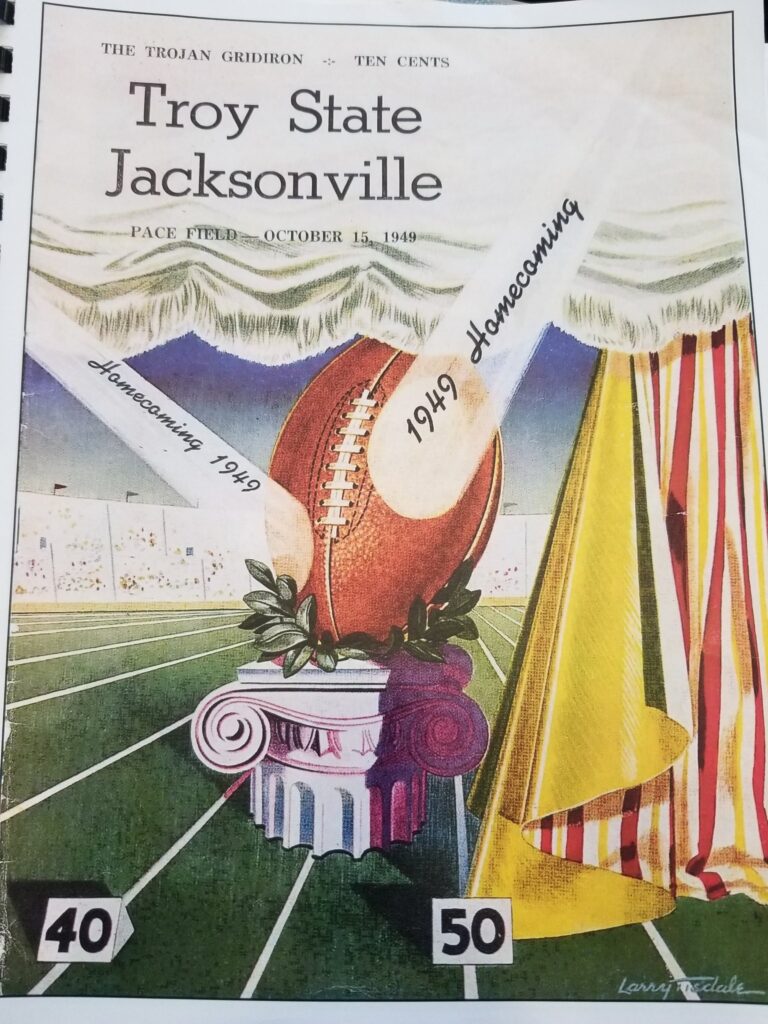
The Trojans would spend the better part of 20 years in Pace Field and the foundations of the modern Trojans were built in the confines of Pace Field. Seven years after beginning play at Pace, Troy would join its first conference, the Alabama Intercollegiate Conference. The Red Wave would bring home three AIC championships to Pace Field. Troy won 54 games against 26 losses and 3 ties in that time. Troy’s first bowl game would come in their penultimate season at Pace, when they would face Jacksonville State in the 1948 Paper Bowl (Played in Pensacola).
You can still make out the old version of Pace Field to this day in the layout of the modern Riddle-Pace Field and Tailgate Terrace. This leaves a permanent reminder of Troy’s first on-campus stadium.
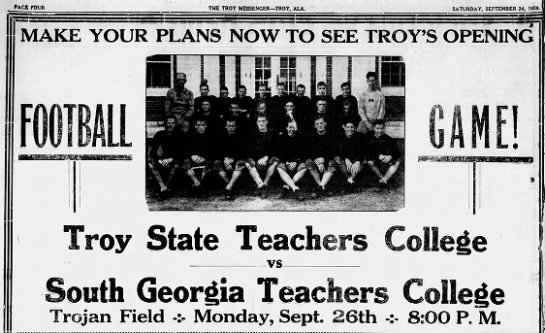
Trojan Field (1938-1941?)
Trojan Field is probably the most mysterious of all of the parks Troy has played. From what I can tell using newspaper archives, Trojan Field was built at the Fair Grounds in Troy. I’m not sure where this would be, but I’m betting it wasn’t at the current Pike County Fairgrounds on 231. It was originally built for the Troy Trojans professional baseball team to use as their home field, but during football season, it was also used by Troy and Troy High School. Due to the inaccuracy of the reporting of the time, I cannot say whether or not Troy played all of its home games at Trojan Field or if Pace continued to be the main home field for the Trojans.
I could only find reference to seven games played during these years: 1938 – South Georgia, Marion Institute; 1939 – West Alabama, Jacksonville State; 1940 – Oglethorpe, Marion Institute; 1941 – St. Bernard. After WWII, Troy began playing back on campus again, with an Oct. 26, 1946 game against West Alabama.
If anyone has any information on Watkins Park, College Athletic Park, or Trojan Field, please reach out to me at @BenOnSports on Twitter or at The Trojan Wall on Facebook.
Check back next week for an extensive story on the permanent (so far) home of Troy football, The Vet.

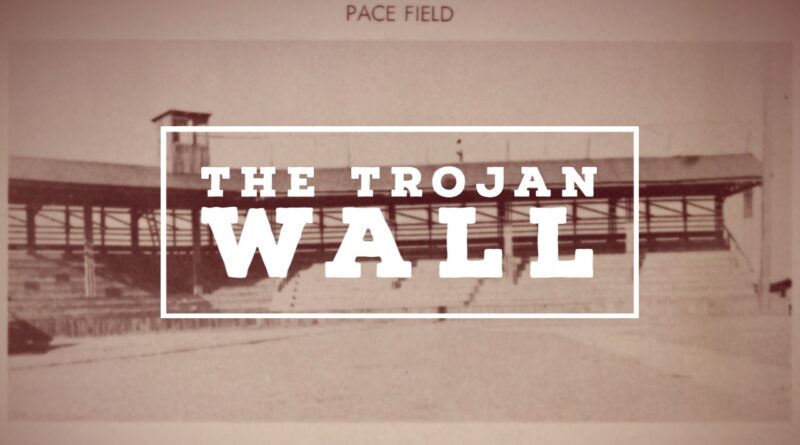
My daddy, Winston Hagler, was on the 1938-1941 team. The family have him a brick outside the stadium for his 80th birthday. Have an article about him being a triple threat. He could run, pass and kick.
I always enjoy your work. Thank you for the good read.
Pike County Fair Grounds were once located on Highway 29 about where you turn onto Gibbs Street.
Concerning the College Athletic Park and the location:
There is a old map at the probate office at the court house. It is dated 1889-1904 and shows street names and is blocked off as to property owners. It shows Orion Street and the block of land belonging to the Gellerstedts. The picture of the map that I have is too small for me to see if the Walter Wilkerson Residence is on the map. It would be worth the time and effort to go the Pike Co. Courthouse and ask for Probate Judge Michael Bunn. He will show you the map and you can get a close up view of the city when the Normal School was located downtown.
1889-1904 street map of Troy available for inspection at the Pike County Courthouse. The map also shows the land blocked of and labeled by owned. It shows Orion Street and the Gellerstedt Land. Probate Judge Michael Bunn will be happy to show you the map.